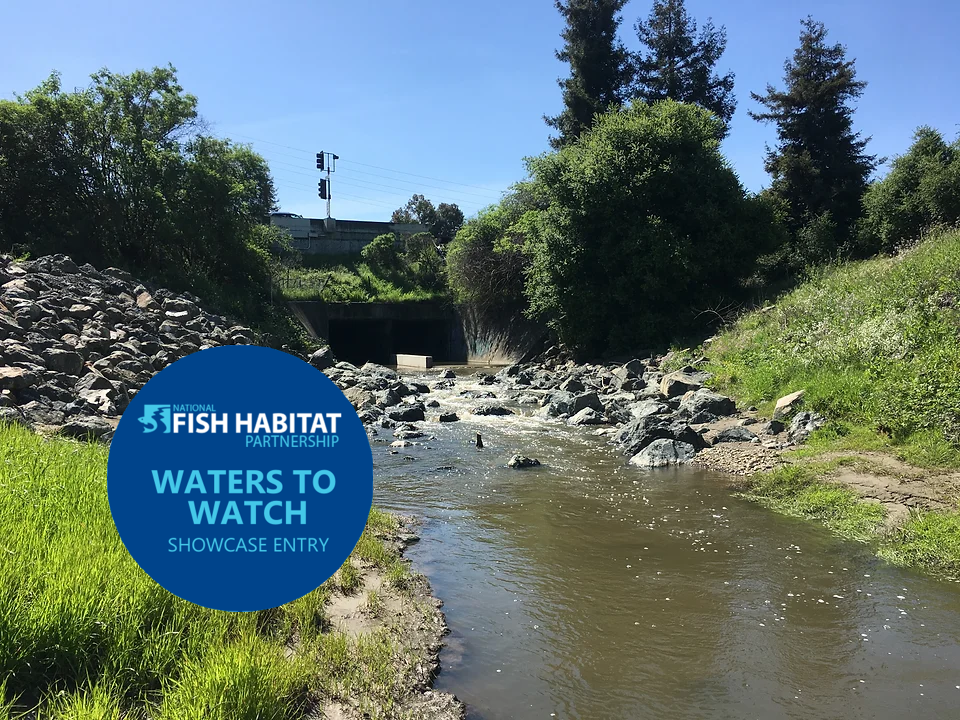Pinhole Creek Fish Passage Project
In 2014 Pinhole Creek was selected at one of the National Fish Habitat Partnerships 10 Waters to Watch. Read more about it here.
Location: Latitude: 37.997110 Longitude: -122.286179
Purpose: This project will restore access to the upper reaches of Pinole Creek for the current population of Central California Coast Steelhead by modifying the existing box culverts where Pinole Creek passes under Interstate Highway 80 (I-80). Habitat assessments conducted on Pinole Creek in 2009 indicate sufficient habitat to support anadromous steelhead spawning and rearing if passage issues at the I-80 culvert are remedied. This project will improve access to nearly 7 miles of documented quality steelhead spawning and rearing habitat on the main stem of Pinole Creek.
Work Performed: The nearly 400-foot-long Caltrans I-80 double-bay box culvert on Pinole Creek creates a severe barrier to upstream passage of juvenile and adult steelhead trout. The culvert slope and shape lack sufficient water depth and produces excessive water velocities at fish migration flows. This culvert crossing, located only 1.5 miles upstream of San Pablo Bay, is the only substantial barrier preventing anadromous steelhead from reaching the high quality spawning and rearing habitat found in the upper watershed. Analysis using FishXing software has demonstrated that this culvert presents a migration barrier to adult and juvenile steelhead at all flows. Pinole Creek has regional significance as one of only a small handful of viable steelhead runs within San Francisco and San Pablo Bays. The I-80 culvert is the only significant barrier to fish passage on Pinole Creek. Monitoring in the upper watershed has indicated steelhead presence only twice in the past 12 years (2002 and 2011). Each year that steelhead cannot reach the spawning habitat in Upper Pinole Creek is a lost opportunity to recover and sustain these populations.
Expected Benefits:
- Fish Passage Enhancement—The project will retrofit a 10’x12′, 320-foot long dual box culvert and apron under Interstate Hwy 80 by constructing a low flow splitter wall (sill) and angled baffle system that keeps low flows concentrated into the south box culvert to increase flow depths for passage at the lower passage flows while allowing for overtopping during higher flood flows into both culverts to limit upstream flooding. On the outlet apron there will be a sidewall constructed to contain flows within the baffled section. The water surface below the outlet would be raised approximately one to two feet with a rock ramp or rock weirs to avoid a large water surface drop at the downstream end of the baffles. Boulder rocks may be also be added to the culvert bottom to assist in fish passage.
- Prioritization—Habitat assessments conducted on Pinole Creek in 2009 by project partners indicate sufficient habitat to support anadromous steelhead spawning and rearing if passage issues at the I-80 culvert are remedied. The I-80 culvert, which is situated 1.5 miles from San Pablo Bay, was identified as the only significant fish passage barrier preventing access to nearly 7 miles of suitable spawning and rearing habitat upstream (EBMUD/Hagar et al., 2009). Watershed assessments throughout Contra Costa County identified Pinole Creek as one of the three most suitable watersheds for salmonid restoration (Contra Costa Watershed Atlas, 2003).
- Monitoring—Biologists from East Bay Municipal Utility District (EBMUD) will perform 3 spawning surveys per season on Pinole Creek. Spawning surveys will confirm presence and spawning success of steelhead in the upper watershed after completion of the fish passage project. Monitoring may be extended beyond 5 years to document spawning success in a variety of water year types (dry, average and high rainfall years). EBMUD will conduct biological for monitoring as an in-kind contribution to the project.
Partners: Contra Costa Resource Conservation District, Friends of Pinole Creek Watershed, California Department of Fish and Wildlife, California Coastal Conservancy, NOAA, California Water Boards, Natural Resources Conservation Service, US Fish and Wildlife Service, Contra Costa County Flood Control and Water Conservation District, Caltrans, Contra Costa Fish and Wildlife Committee, City of Pinole, East Bay Municipal District, and the California Fish Passage Forum.
Total cost of project: $785,625







